#Smallpox Tale
Explore tagged Tumblr posts
Text
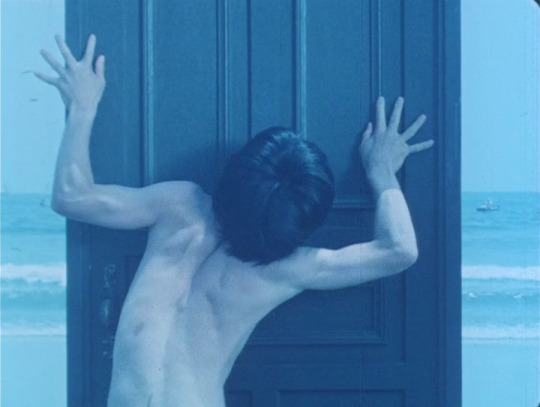
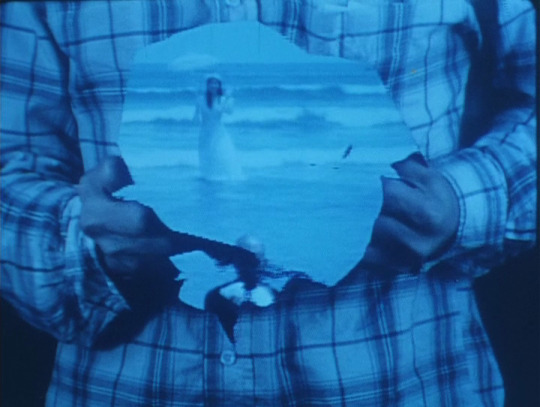



Smallpox Tale (Shūji Terayama, 1975)
454 notes
·
View notes
Text





A Tale of Smallpox (1975) // dir. Shūji Terayama
145 notes
·
View notes
Note
Is shattering permanent in the comic (especially with the force fusions and cluster) or can it be fixed down the line like future did? Asking for your opinion on this too bc I found out about it in Future and it makes me feel weird (bc now it feels like any SU stuff and shattering has no consequence or tension, so haven’t been able to read or write stories). Maybe I’m seeing this wrong? Would love your thoughts

Hmm...
So to answer your first question: The comic for WDAU works on the same rules as canon does. I have no intention to over-write anything canon clearly stated to be true.
The ability to put back together shattered gems is definitely a part of that.
So yes, theoretically, even in WDAU, gems being shattered is not 'the end' because they can be eventually re-instated through the work of the diamonds, IF they someday decide to Change Their Minds like they did in the original series.

That being said...
I want to talk a little bit about something you said, because it tickles my brain in an interesting way:
"now it feels like any SU stuff and shattering has no consequence or tension"
And the best way to talk about stuff, I've found, is to ask questions about our underlying assumptions. So my questions for you (all) today are:
For us humans, death certainly IS a constant that remains ever-permanent, and thus it's easy to compare it to shattering and draw that parallel... but is that a fair comparison?
In fiction, death is often circumvented and there still remains reasonable tension in things like magic-heavy worlds, vampire novels, sci-fi where almost any sickness is eradicated, etc. Is this not quite similar to what shattering is for gems?
Is the perceived permanency of shattering the only reason it feels like a heavy consequence?
Are there OTHER consequences of being shattered that make it just as interesting, if not more than, to be explored as a plot device?
Must there be an ever-looming threat of something horrible and permanent happening to make a story good?
There isn't a right or wrong answer to these questions, necessarily. I'm not posing these in order to lead you to a singular, 'absolutely correct' conclusion or way of writing.
For some stories, death DOES need to be permanent in order not to make light of what the characters go through! In some forms of writing, there IS no other way around that consequence.
But I daresay SU is not one of those stories.
Let me put it this way - 100 years ago, medicine had only BEGUN to develop into the thing we know it as today. Sure, there were therapies and treatments for diseases, broken limbs, poisonings, etc. Some of them were quite good, even! But overall, the death tolls back then from basic illness were MUCH higher than they were today.
Pnumonia, Malaria, Syphillis, Smallpox, Bubonic Plague, AIDS.
These were things that people died from, with near CERTAINTY, for the LONGEST time. They were considered the road to a permanent black screen.
And today? Even though they are still, without proper intervention, JUST as deadly, we now have new tools and vaccines to combat them. Hell, if you get vaccinated fast enough you can get bit by a rabid dog and live to tell the tale, unscathed! Rabies used to be a one-stop-shop to the afterlife.
Despite this, we still view these diseases with appropriate fear. They are still dangerous - in the right conditions.
In the right conditions, the consequences for a LOT of things can be permanent. If permanency is what you're looking for.
So alright, the Diamonds can heal shattered gems now. Booooring. How easy it is to fix any shattered gem! What a simple solution to anything tragic.
But................... will they ALWAYS do so?
In fact...will the Diamonds ALWAYS be around?
Will the gems who got shattered always be picked up, piece by piece, and be brought back to them, perfectly preserved? Or will they lose pieces of themselves along the way - literally?
And what NEW consequences can we think of, when we stop thinking of the permanency of death, and start thinking of the Impermanence of those tools that keep us here longer and longer?
Just food for thought. 👀
306 notes
·
View notes
Text





On August 29th1930 the population of St Kilda were evacuated from the island.
There is a common misconception that they were forced to leave their homes but after struggling to make ends meet and a dwindling population making matters worse they asked to be evacuated, the population fell from 73 in 1920 to 37 in 1928, the loss of four men to influenza in 1926 hit the islanders hard. Another fact that many don't know is that St Kilda is actually the name of the archipelago, the main island of Hirta is where they loved but there are three more islands, Dùn, Soay and Boreray.
Dùn is nearly a mile long. Its name simply means "fort" in Scottish Gaelic but the fort itself has been lost - old maps show it on Gob an Dùin, which is at the seaward end. The small island is home to the largest colony of fulmars in Britain. Dùn was at one point joined to Hirta by a natural arch, a romantic tale says it was struck by a galleon fleeing the defeat of the Spanish Armada but the general consensus is it was simply swept away by one of the many fierce storms which batter the islands every winter.
Soay is the westernmost point of land in Scotland, and also the westernmost point in the British Isles, excluding Rockall. The name is from Old Norse Seyðoy, meaning "Island of Sheep". It is unlikely that this island ever had permanent habitation. Men from Hirta would stay for a few days while gathering wool. There are two sea stacks, Stac Biorach and Stac Shoaigh between Hirta and Soay.
Boreray has the Cleitean MacPhàidein, a "cleit village" of three small bothies used on a regular basis during fowling expeditions from Hirta. Boreray is recognisable for the stacks Stac an Armin, Stac Lee that are close to it, a remarkable story about Stac an Armin, on the far left in picture two is that three men and eight boys from Hirta were marooned here from about 15 August 1727 until 13 May 1728. As luck would have it, Hirta suffered a smallpox outbreak while the eleven were on the stack, and thus the islanders were unable to man a boat and retrieve them until the next year.
Hirta is the largest island at just over 2 miles long, it was populated from prehistoric times until this day in 1930 when the 36 inhabitants were removed to Morvern on the Scottish mainland at their own request. I will leave you with this description of the day.....
"The morning of the evacuation promised a perfect day. The sun rose out of a calm and sparkling sea and warmed the impassive cliffs of Oiseval. The sky was hopelessly blue and the sight of Hirta, green and pleasant as the island of so many careless dreams, made parting all the more difficult. Observing tradition the islanders left an open Bible and a small pile of oats in each house, locked all the doors and at 7 am boarded the Harebell. Although exhausted by the strain and hard work of the last few days, they were reported to have stayed cheerful throughout the operation. But as the long antler of Dun fell back onto the horizon and the familiar outline of the island grew faint, the severing of an ancient tie became a reality and the St Kildans gave way to tears."
40 notes
·
View notes
Text
Get MOST TRUSTED ADVISORS at a LORDLY PRICE!
Hear ye, hear ye! Itch.io, those fine purveyors of princely manuscripts and amusements, have declared that today they will not longer collect their dastardly tithe upon this dreadful day of plagues known as 'black Friday'.
This means our comic production, Most Trusted Advisors, the dice-playing merriment game of roles and betrayal, is now available at the sort of price you can usually only negotiate through pillaging or leveraging generational wealth!

WHAT IS MOST TRUSTED ADVISORS?
Most Trusted Advisors is a tabletop roleplaying game, crafted by the finest computer artisans for all your madcap, absurdist, feudal comedy one-shot or short campaign needs. From the dastardly Blackguard to the hopelessly naive Lover, pick one of the game's six playbooks and roleplay as the untrustworthy, scheming council to a bumbling Liege.

Betray the king! Usurp the throne! Catch smallpox! Tell dire tales of intrigue and betrayal! Catch smallpox again even though you thought you were immune! All these roleplaying experiences and more will become available to you with the purchase of our fine manuscript, which is 50% OFF until Tuesday, 28th of November. It's guaranteed to get your soul into heaven!*
*Purchasing MOST TRUSTED ADVISORS is not a recognized indulgence in the eyes of most certified bishops. Please consult your local clergyman.
109 notes
·
View notes
Text
Ye Olde American Pulp Department:
Independence Day draws near! Let's celebrate with a tale of America's first masked hero.
THE DEADLY PLAN OF DOCTOR POX! © by Rick Hutchins
“Call me Doctor Pox, my dear,” said the man in the scarlet cloak and theatrical tragedy mask, as he finished binding her wrists behind her back. Beneath the cloak, his proper British attire was spattered with mud from hard-riding the buckboard through the night.
“How dare you?!” she cried for the millionth time. “My father is Colonel….”
“I know your father!” screamed Doctor Pox, silencing her. He quickly regained his composure. “My dear Sybil.”
Turning on his heel, the madman marched off to a dark corner of the barn, out of the small circle of light cast by the single kerosene lamp.
Sybil struggled against the leather straps that bound her to the wooden beam, but to no avail. Her light blue Polonaise gown had been torn to shreds in the struggle and her low-cut bodice had been ripped, exposing an unseemly amount of decolletage. Strands of brown hair fell in her face, her bonnet having been lost in the kidnapping.
Doctor Pox reappeared from the shadows, dragging something heavy through the dirt and straw. “Yes, my dear,” he said, “I met the esteemed Colonel Willing during the Siege of Boston. He was so proud of his cannon upon Dorchester Heights. So proud of his ruffian irregulars who guarded the roads.”
He was dragging a large wooden coach trunk with iron braces; huffing and puffing, he positioned it three feet in front of Sybil. Leaning in close to her, his theatrical tragedy mask, which seemed wrought of copper, hovering near her face, he said, “It is my tender sentiment for your father which has brought you here.”
With a flourish of his scarlet cloak, the doctor turned and flung open the top of the trunk.
When Sybil saw what was inside, she screamed.
And with that, the barn doors burst open and in strode a tall and stately figure.
“Goodman America!” gasped Sybil.
His face entirely masked by white cloth, the famed mystery man was dressed in a waistcoat and tricorn hat of brightest blue; his vest bore thirteen red and white stripes. His breeches were midnight black, as were his rugged highwayman boots. The knob of his walking stick and the rattlesnake insignia on his hat were rumored to be of pure silver, smithed by Paul Revere himself.
“Surrender, Doctor Pox!” he commanded.
“Never!” replied the madman, drawing a flintlock pistol from beneath his scarlet cloak.
But Goodman America was upon him in an instant and knocked the weapon from his hand before he could fire. The two masked men faced off, circling each other warily, preparing for hand-to-hand combat.
Grimacing with disgust, Sybil reached out with her foot�� she had lost her shoes in the scuffle as well– and knocked the coach trunk shut with her stockinged toe.
The noise distracted Doctor Pox for but a moment, but it was enough for Goodman America to throw a punch. The mighty blow knocked the theatrical tragedy mask from the madman’s face.
Both Sybil and Goodman America recoiled in horror, for that face was so hideously scarred and twisted that it was barely human.
“Look then!” shrieked the doctor. “Look upon the face of Doctor Silas Conduct! See what the smallpox epidemic of the Siege of Boston did to me! If Colonel Josiah Willing had let us pass that night, I would not be thus disfigured– and my beloved wife would not be DEAD!”
He pointed savagely at the coach trunk.
“But when the bits and pieces of the rotting human remains in that trunk, raging with smallpox, are added to the food and water of the Continental Army, then so too will the American rabble die! And the daughter of my most hated enemy will be the first to….”
The silver knob of Goodman America’s walking stick struck the doctor’s temple sharply, and he fell unconscious to the ground.
“Don’t tread on us,” said Goodman America.
Drawing an officer’s saber from a scabbard hidden beneath his blue waistcoat, he quickly went to work cutting the leather straps that bound Sybil Willing.
“Hurry!” she cried. “We must get away from that horrid trunk!”
As Sybil ran ahead through the open barn doors in her stockinged feet, the masked Patriot grabbed Doctor Pox by the cloak and dragged him out into the night.
“Wait here,” he told Sybil, as he dropped the doctor’s body in the dirt and ran back into the barn.
Taking the kerosene lamp from its hook by the door, Goodman America smashed it upon the coach trunk. Within seconds, flames had engulfed the trunk and begun to spread to the straw and wooden beams.
Returning to the barnyard, as the flames rose into the night sky behind him, the Revolutionary Hero looked around.
“Where has Doctor Pox gone?” he asked.
“He ran off across the fields,” answered Sybil. “But no matter! When that madman kidnapped me, my gentleman friend, Mister Nathan Hand, was knocked to the street and hurt. He is a man of learning, not combat, and I fear for him!”
“Then rest your fears,” said Goodman America. “I have already seen to Mister Hand and he is even now being tended to by the Sons of Liberty in their meeting place.”
“Thank God!” cried Sybil.
And beneath his white mask, Nathan Hand smiled.
#short story#short fiction#microfiction#flash fiction#pulp fiction#pulp heroes#independence day#4th of july#rjdiogenes#rick hutchins
31 notes
·
View notes
Text
Japanese Monkey God
User @red-lights-burning asked if there was a connection between Sun Wukong and the monkey gods of Japan. They provided lovely info, which was split between two asks, but I decided to put everything together into a single post.
@red-lights-burning asked: Japan has their own monkey protector named Masaru AKA Sannō Gongen, who was created back in the early 9th century by Tendai Buddhist sect founder Saichō shortly after he returned from China. So it makes me think if Monkey King was already a thing in the 800’s and if he was one of the inspirations for Masaru. A description from onmarkproductions (a really great site for anyone curious about Japanese Buddhism and Shintō) MASARU 神猿 Literally “Kami Monkey.” Masaru is the sacred monkey and protector of the Hie Shrine (aka Hie Jinja ��吉神社, Hiyoshi Taisha 日吉大社). The term “Masura” is often translated as “excel,” reflecting the belief that this sacred monkey can overcome all obstacles and prevail against all evil. Masaru is thus considered a demon queller par excellence (魔が去る・何よりも勝る). In the Heian era, Masaru (also translated “Great Monkey”) was invoked in Kōshin rituals to stop the three worms from escaping the body. Masaru also appears in Japanese scrolls used in Koushin rites. Here’s a couple other descriptions SANNŌ GONGEN 山王 権現 SARUGAMI 猿神 Fertility, Childbirth & Marriage Monkeys are patrons of harmonious marriage and safe childbirth at some of the 3,800 Hie Jinja shrines in Japan. These shrines are often dedicated to Sannō Gongen 山王権現 (lit. = mountain king avatar), who is a monkey. Sannō is the central deity of Japan’s Tendai Shinto-Buddhist multiplex on Mt. Hiei (Shiga Prefecture, near Kyoto). The monkey is Sannou’s Shinto messenger (tsukai 使い) and Buddhist avatar (gongen 権現). The monkey messenger is also known as Sarugami (猿神; literally “monkey kami”). Sarugami is the Shinto deity to whom the three monkeys (hear, speak, see no evil) are reportedly faithful. The monkey shrine at Nakayama Shrine 中山神社 in Tsuyama City, Okayama Prefecture, is dedicated to a red monkey named Sarugami, who blesses couples with children. According to shrine legends, the local people at one time offered human sacrifices (using females) to this deity. The shrine is mentioned in the Konjaku Monogatari-shu (今昔物語集), a collection of over 1000 tales from India, China, and Japan written during the late Heian Period (794-1192 AD). Sarugami, like Sannou Gongen, is also worshipped as the deity of easy delivery and child rearing. At such shrines, statues of the monkey deity are often decked in red bibs -- a color closely associated with fertility, children, and protection against evil forces and diseases like smallpox.
My answer:
I've read only a little bit about Japanese monkey gods. I previously referenced Sarugami in my article about the possible shamanic origins of primate-based boxing in China. Part of footnote #14 reads:
In Japan, monkeys were also associated with horses and healing via the warding of evil. Apart from monkeys being kept in stables like their Chinese counterparts, their fur was applied to the harnesses and quivers of Samurai because the warriors believed it gave them more control over their mounts. Furthermore, monkey body parts have been consumed for centuries as curative medicines, and their hides have even been stuffed to make protective amulets (kukurizaru) to ward off illness. Likewise, a genre of painting depicts divine monkeys (saru gami), messengers of the mountain deity, performing Da Nuo-like dances to ensure a good rice harvest (Ohnuki-Tierney, 1987, pp. 43-50)
The aforementioned article suggests a connection between monkeys and the Shang-Zhou Da Nuo (大儺 / 難; Jp: Tsuina, 追儺) ritual, an ancient, war-like, shamanic animal dance designed to drive away demonic illness and influences. The pertinent section reads:
It’s possible that the “twelve animals” of the Da Nuo exorcism refer to some precursor of the Chinese zodiacal animals (rat, ox, tiger, rabbit, dragon, snake, horse, goat, monkey, rooster, dog, and pig). If true, monkey fur could have been among the animal products worn by the ritual army. After all, monkeys have long been associated with curing illness and expelling evil in East Asia. [14] A modern example of exorcists who don monkey fur are the shamans of the Qiang ethnic group of Sichuan. The Qiang worship monkeys as the source and savior of their sacred knowledge, as well as the progenitor of their people, the latter being a myth cycle common among ethnic groups of Tibet and southwestern China.
This is the only relevant info that comes to mind. But based on what I know, I would guess that Sun Wukong and the monkey gods of Japan draw upon the same cultural sources. I hope this helps.
Source:
Ohnuki-Tierney, E. (1987). The Monkey as Mirror: Symbolic Transformations in Japanese History and Ritual. Princeton: Princeton University Press.
#asks#Sun Wukong#Monkey King#Journey to the West#JTTW#Japanese Buddhism#Shinto#Buddhism#monkey god#shamanism#Lego Monkie Kid#LMK
76 notes
·
View notes
Text
It's an almost banal truism that classic science fiction was largely a projection of the Frontier Experience - and, more broadly, the whole world-shaking events of the European Age of Discovery - onto an imagined outer space. Less frequently remarked is that the reverse is also true.
I grew up devouring Golden Age science fiction novels, and was a fervent believer in Mankind's Destiny Among The Stars. Well, the Space Age - like all the great dreams of thr 20th century - has turned out to be something of a damp squib, but I still want stories of fantastic voyages of exploration, adventure, science, discovery, and intrigue in a vast new world of far-flung outposts separated by titanic distances. So to scratch that itch, why not just...go back to the source?
If you want something like a story about an isolated asteroid mining colony, you can just read the memoirs of a surgeon at a Hudson Bay Company outpost! Why bother with Heinlein when you can just read the diaries of pioneer women, the tales of Yankee filibusters in Latin America, the authentic exploits of desert-island buccaneers, or the early adventures of the Portugese in the Indian Ocean? Do you want fraught tales of inteigue and war and high politics that extend to the farthest reaches of known space? A good book on any of the big 18th century wars for empire will satisfy. And can Star Trek remotely compare in imagination and excitement to the voyages of Cook and La Pérouse? "Strange new worlds, new life, and new civilizations?" Boy howdy, we got 'em! If you look at these things with fresh eyes, with the eyes of a science fiction fan rather than those of someone with access to an infinitide of pictures of them online, nothing could be more surprising than a dugong, a platypus, a redwood, a southern continent of solid ice.
All of this is really just an overly long preamble to my main point, though. Which is that I believe the story of Hernán Cortés, Montezuma, and the Conquest of Mexico to be possibly the greatest one ever told. The themes...bro, the themes! There is here a richness, a complexity and depth surpassing almost anything I can think of in legend or literature.
It is, of course, a science fictional First Contact story, in which two shockingly different civilizations who know nothing of each other suddenly find themselves facing each other down. And indeed, like any good First Contact story, one of the principal characters, La Malinche, is an interpreter! See how the resulting clash of civilizations eludes simple stereotyping - sure, it's easy to see the Spaniards as brash young interlopers into the sophisticated and urbane world of the Aztecs, whose capital was perhaps as much as an order of magnitude more populous than any city in Spain. But equally it is possible to see the Aztecs as provincials, isolated from a wider, older world that suddenly irrupts into their narrow one. Consider that Cortés supposedly got practical advice on political machinations and military strategy by - studying Caesar! Access to ancient wisdom penned by dead hands in far-off lands provides material aid to him.
Then there are the religious themes. It can be seen as a story about the triumph of Christianity, of the Church Triumphant, but what does it mean for a religion founded by a suffering martyr to become militarily triumphant? And what does it mean for thr religion of a suffering martyr to become triumphant over a religion of human sacrifice to the gods? This is a complex and multi-layered irony that spares no one. And consider the strange foreshadowing of the legend of Quetzelcoatl returning from over the sea. Shades of Frank Herbert, here, even (especially?) if the tale is a post-conquest invrntion.
And the role of technology in the tale. Yes, the steel and shot, the horses and hounds, the ships and sails were all powerful allies for the Spaniards, but these would not have sufficed without the smallpox virus - a reversal of Wells that still underlines the power of biology and of the very small even in the face of all our mastery over the brute world. But the conquest also would not have been possible without the alliance with the Tlaxcala and other local rivals and adversaries of the Aztecs. There are very pointed lessons in the social, political, and diplomatic sciences being demonstrated here. Some are obvious, and others very subtle - look at the ways these differing civilizations reacted under the extreme stress of this brutal war to see what I mean about the subtle ones.
I could go on, I could mention the strange aesthetic touches, such as the similarity in climates between the Valley of Mexico and inland Spain, and the parallels between Spain's role to Rome and Mexico's to Spain; or I could talk about the fascinatingly ambiguous characters of all the major players in this story, and the surprising arcs they go through; but not only am I already going on rather long, but I fear I may be making too light of what were, after all, real events, real events that resulted in piles of corpses, and whose tremendous human consequences are still felt deeply by tens of millions of people.
But I stand by my statement that it is one of the richest, profoundest stories I know of. The gods may be cruel, monstrously cruel, but they are artists, too.
20 notes
·
View notes
Text

Ropes Mansion, located in Salem, Massachusetts, is a historic Georgian Colonial mansion that was built in the 1720s Originally built for merchant Samuel Barnard, the home was later acquired by Judge Nathaniel Ropes in 1768.
Nathaniel Ropes was a well-known person in Salem, serving as a judge and a member of the Governor’s Council. In 1774 during the American Revolution there was an attack on Ropes Mansion, Nathaniel succumbed to smallpox shortly after this incident.
The mansion is as famous for its haunted tales as it is for its historical significance. Stories of ghost sightings have surrounded the mansion for many years. One of the most well-known ghosts said to haunt the Ropes Mansion is Abigail Ropes. Abigail was the daughter of Judge Nathaniel Ropes II, in 1839 she died in a fire that started in the mansion. According to legend, Abigail’s spirit is tied to the mansion, unable to move on from the place of her death.
Visitors and staff have reported seeing a ghostly figure, believed to be Abigail Ropes, walking through the halls and appearing in the windows. Some have felt sudden drops in temperature, unexplained noises, and the feeling of being watched. The haunting stories have been passed down through many years adding to the mansion’s attraction.
Today, the house is owned by the Essex Institute’s successor, the Peabody Essex Museum. It is one of a number of historic homes owned by the museum, and it stands as an important architectural landmark. However, it is a major tourist destination in modern Salem for different reasons. The 1993 film Hocus Pocus used the house as a filming location, and it was prominently featured as the home of one of the main characters, Allison Watts.
#historic properties#historic houses#salem#haunted house#haunted places#Abigail ropes#autumn#spooky season#history#vintage#ghosts#spirits#home & lifestyle#hocus pocus
14 notes
·
View notes
Text

Smallpox Tale (1975) - dir. Shūji Terayama
#shūji terayama#surrealist cinema#experimental cinema#avant garde cinema#japanese cinema#movie scenes#movie gifs#film gifs#cinema#surreal#surrealism
33 notes
·
View notes
Text






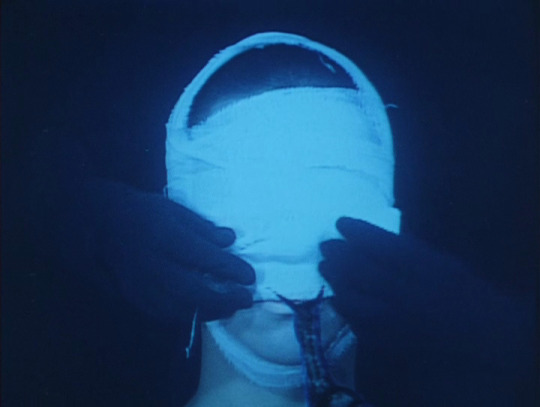

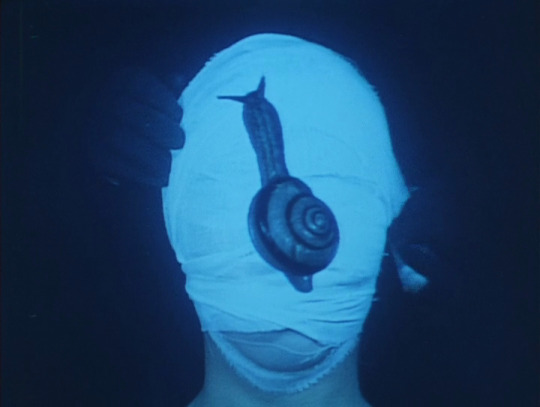

Smallpox Tale (Shūji Terayama, 1975)
#Smallpox Tale#Shūji Terayama#Terayama#Shuji Terayama#short film#1975#experimental film#surrealism#experimental cinema#colour#blue#faces#animal#animals#snail#Hôsô-tan#Hoso tan#Hôsô tan#Keiko Niitaka#Yoko Ran#Takeshi Wakamatsu
123 notes
·
View notes
Text
Deadman Island Hauntings
Tucked away in the waters of Vancouver, British Columbia, Deadman Island is a place of mystery and spooky lore. This little, unassuming island has a rich history that contributes to its reputation as a haunted place. Events that have left a lasting impression on its history have given rise to frightening legends and ghost stories. Even the island's name alludes to its somber past. During a smallpox outbreak in the late 1800s, Deadman Island served as a quarantine location. Unmarked graves buried the plague victims and those who succumbed to other diseases here. Many people attribute the island's eerie aura to this dark period in its history. The widespread belief that the restless ghosts of those who perished there still roam the grounds accentuates the island's spooky charm.

Both natives and visitors have recorded numerous paranormal events on the island. People who have visited often tell stories of strange lights, spectral apparitions, and unexplainable noises. Some people say they have spotted individuals walking down the shoreline dressed in period attire, but they always disappear when they get close. Others have reported hearing whispers and disembodied sounds borne by the wind, adding to the island's eerie reputation. One of the most persistent stories revolves around the ghost of a young woman frequently spotted near the water's edge. Local legend states that she looks for a missing loved one and that everyone who comes into contact with her senses her melancholy presence. Like many other stories about Deadman Island, this one captures the profound sense of loss and unsolved sorrow that appears to pervade the place. Despite its eerie reputation, Deadman Island remains closed to the public, heightening the sense of mystery and intrigue. The Canadian Navy's use of the island primarily renders it inaccessible, fostering curiosity and speculation about its true nature. This limited access only heightens the mystique, leaving much to the imagination and allowing legends to run wild.

The island's paranormal appeal demonstrates both human attraction to the unknown and the power of storytelling. It acts as a reminder of the narrow line that separates fact from folklore and history from legend. The stories of Deadman Island captivate the imagination and transport readers to a realm where the past never really rests, regardless of whether they are believers or skeptics. Deadman Island is essentially a representation of the rich history and mystery of Vancouver. Its paranormal legends continue to captivate listeners, offering a glimpse into the island's eerie past. The charm of Deadman Island continues, beckoning everyone who hears it to delve into the shadows of its legendary past, even though the truth behind these tales may never be completely revealed.
#deadman island#vancouver#ghost#paranormal#ghosts and hauntings#ghosts and spirits#ghost stories#ghost art#haunted island
6 notes
·
View notes
Text
Flower

Word count: 1.9k
Content Warnings: reader changes gender with each revival, mcd (over and over again), homophobia (by the law it's the 1900s)
Summary: You just. keep dying

99:99:99:99:98
The first time Hinata meets his soulmate, the clock on his wrist hits 0:00 right as he watches a woman fall over from an arrow to the head. Hinata found it horrendously strange. Surely it wasn't them? Yet, as he pauses to look at the body while the rest of the army charges into the village, the watch on his wrist changes to a new number. It was the dead body.
Hinata groans, fleeing the scene as the rest of the army breaks into the village.
The red bleeds with the color of the stained dirt, and Hinata's breath grows ragged as he dodges arrows and swords. The horses will arrive soon, he thinks. His heart races in his chest, praying, begging that somehow he would be able to escape this. As he runs through the woods into a cottage, something pierces his wrist, and he watches in horror as his clock cracks. He pauses, lips parted in shock, and he stares at the soldiers as they try to strike him. His skin doesn't bleed. He stares at the sword stabbed through him, staring down at the metal and the lack of blood. He pulls the blade from his skin, staring at the man before him. How fun.
87:24:13:92:42
The second time Hinata meets his soulmate, they're a man.
His timer is still cracked, healing slowly. He's made use of himself, working back and forth for the villagers, acting as a doctor's assistant. He doesn't know how many towns he's changed, but he's always started over when he did. It's always a lie.
"I'm new here." He is not.
"Doctor!" A woman rushes in a young person. Hinata assumes they work in the fields. It's another case of smallpox. Hinata glances at the clock. The clock on his wrist burns, and he stares down at the dying man. "Please help my son!"
The woman is hauled out as she cries, and Hinata glances at the clock once the doctor proclaims him dead. Another life. Then.
"Dead at Twelve forty-two, on the Nineteenth of December, the year of seventeen twenty four." Hinata reads. "My greatest condolences, madam."
She sobs, screaming in the crowd, the wails that could stir up the dead, and he watches as she is locked away for hysterics, and he stares at the timer on his wrist. Ah. It restarted again. That must've been his soulmate.
He locks eyes with the dead man, offering him a lily. "May we meet again."
79:91:91:99:96
The third time he meets, they're a child. A young child. A child that coughs and throws up blood on the field, and he rushes to his aid, patting his back, trying to get his air pipe to work. It doesn't. Nature takes people in the cruelest ways at the worst times. Yet, he sits in the field, the child on his lap, mumbling quiet fairy tales he grew up with as the child loses his life.
He can't love them. They're a child.
He can't have them. They're dead.
His hair has grown longer now. It frames his face, and he sighs, staring at the timer that has less cracks this time around.
"Thus, the maiden live happily ever after," He looks into the distance, the lack of a parent. So, he takes the body with him, giving him a proper burial, leaving a lily at the grave, silently offering his prayers to send him to the next life safely.
He gets back onto his feet, standing at the grave, staring wordlessly at the single flower.
He wonders when he'll meet them again
66:91:90:87:13
The fourth time he meets them, they're an old woman. She hisses and smacks people with her cane, sitting down in the pub for a pint of beer. Hinata doesn't know why he moved, even with the endless racism directed at him. He wonders if he'll be something more than a worker in a sugarfield. It's terribly hot on the islands. Yet, he blinks slowly at the woman and she stares back at him.
"What a fine young fella," She laughs, ignoring the burning of time on her wrist. "So? What brings you here? You seem to be a field worker."
"Yes." Hinata sits next to her, staring at the timer on his wrist. It's hit zero again. "Soulmate?"
"I'm too old for you, dearie. I should be out rotting in my good for nothing brother's house, but I can't stand it there." She laughs.
It's surprisingly boisterous for someone who seemed to be aged beyond belief.
"So? You look mighty young. What happened?"
"It's a long story," Hinata presses the beer to his lips, chuckling. "How about you?"
"My life has been long, but I suppose it's great. The war is coming, dearie."
"Gives me deja vu."
The woman presses a pill to her lips, biting down, the poison spreading through her body.
Hinata catches her before she can fall, and she brings her back to her brother's house, where she's given a funeral. He stands there, her granddaughter tilting her head at her, asking if he had met his soulmate yet. He doesn't have the heart to tell her that she just passed away.
"My timer got damaged." He shows the young girl. "It is still healing."
"I hope it heals soon." She smiles.
52:91:42:24:58
The fifth time Hinata meets his soulmate, the two of them are on the battlefield again. It's a man. He's not as surprised as he should be, but he finds himself sitting in the air force base, talking to a young man, a smile on their faces, a grin on their lips. It's his soulmate, but he can't have them. Not this time. Perhaps not the next. Hinata does not know when he will be able to.
His soulmate is a Kamikaze pilot. It breaks his heart.
"Can't you run away with me?" Hinata quips cheekily, a smile on his lips.
"I can't." He shakes his head. "I must die for the country, for that is the greatest way to go out."
"That is not true." Hinata frowns.
"And besides." He stares at the timer on his wrist. "It is a mistake."
Hinata's words catch in his throat, his heart-shattering in his ears. Yes. It was illegal. It was against the law. There was no such thing as a boy loving a boy, for they were both sinners under the law.
"Do you think I will be reborn as a woman in my next life?" The man stares at the alarm as it starts blaring.
"Even if you are not," Hinata rests his forehead on his, just for a moment, the skip of the clock, a heartbeat. "I will still love you."
Hinata wakes up the next day to the list of dead pilots.
His soulmate was one of them.
47:82:14:24:45
The sixth time Hinata meets his soulmate, they're a baby. A literal baby.
A baby who had died in the first bombing of Hiroshima.
Hinata helps the rest of the victims who had suffered from the radiation, but as one of them hand their crying baby to him, his breath hitches. His soulmate. Died.
Again.
A baby this time. A child who had just been born.
Hinata fights the tears in his throat, and he grimaces at the baby.
"Sir?"
"It's fine." He holds the child to his chest, pausing, spacing out, heartbreaking. "I'm sorry about the child."
"It's alright." The woman smiles sadly. "He would have been gorgeous, just like his father."
Yes.
After all, you've been gorgeous in every life he's met you.
32:13:14:48:02
The seventh time Hinata meets his soulmate, she's a woman well into her twenties. She's married despite the lack of soulmates, but she's married.
"Happy to be married, miss?" He slides into the seat next to her at the diner, raising a brow.
"Mm," She fiddles with the ring on her finger. "Married well, yes. I'm not sure how great of a husband he would be considered, though."
"That's unfortunate." He smiles, staring at the timer on his wrist. "I heard there are cases of abusive husbands lately."
"That's true," The woman laughs. "Well, what brings such a looker as you here to this part of town? This is where all the ladies hang out, you know?"
"Yes." Hinata hums. "I thought it would be the place to find you." He stares at the timer on her wrist, and she follows his gaze.
"Ah, so you're my soulmate." She smiles. "It's a shame I'm married already. I can't get a divorce in a society such as this."
"I'm aware." Hinata shakes his head. "Well, I hope you—"
"Stay for a little, will you?" She smiles at him, sadly, maybe. It was as if you knew the two of you were star-crossed. "Just to listen?"
She rambles to him about her life, from the excitement of marrying into a wealthy family to the doom of her life after the marriage, and she talks about the kids. The children. She loves her children even if the family was terrible for her. She lost count of how many mistresses her husband had, and she lost count of how many times she's thrown her wedding ring away in frustration.
"So?" Hinata tilts his head at her. "Will you leave with me?"
"I can not, for I have children." She smiles at him. "Our lives will overlap soon. I promise."
You ended up killing yourself the day the children turned 18.
Hinata stares at the headline of the newspaper.
"Gold digger commits suicide after children turn of age!"
Hinata throws his copy into the trash.
15:13:45:28:06
The eighth time he meets his soulmate, he's volunteering at a mental hospital. He's not sure if it's for the aesthetic, but his hair has grown long beyond repair, and he has to tie everything back.
His soulmate is a teenager, sitting in their room, drawing on the walls.
"Lunchtime."
"I can't believe my soulmate is a grown ass man."
"I know." Hinata sighs. "Come on. Get to lunch."
"What's being served today?"
"I don't know." Hinata leads them to the dining room, and they sit down, eating.
"I want to grow up faster."
"No you don't."
"I don't."
Hinata stares at the hanging body from the ceiling fan this time, sighing, dialing the number for the janitors.
He wonders when the next time will be.
00:00:00:04:03
The final time Hinata meets his soulmate, you're on campus in a university. Hinata doesn't know how long he's waited for the moment, but as he locks eyes with you across the campus, he's running. He doesn't know why he enrolled in the college to get a degree when he was richer beyond comprehension. He doesn't know why he decided this college of all the possible choices, but as he's chasing you down the block, he thinks he knows.
"Timer!" He yells, grabbing your wrist, pointing at his own as it hits zero. "Soulmates. We're soulmates." He pants. "I'm so sorry if I come off as creepy. I've just been." He heaves. "I've just been looking for you since forever ago."
You blink at him, eyes wide, throat dry.
"Um, yeah!" You free your wrist, and you stare at the time. "So, um. Name?"
"Hinata," He smiles. "Hajime Hinata."
"Pleasure to meet you."
"Please don't die again."
"I'll try not to this time."
Hinata makes sure of it.
#hajime hinata x reader#hinata x reader#hajime x reader#danganronpa x reader#sdr2 x reader#hajime hinata#☾.fics
50 notes
·
View notes
Text
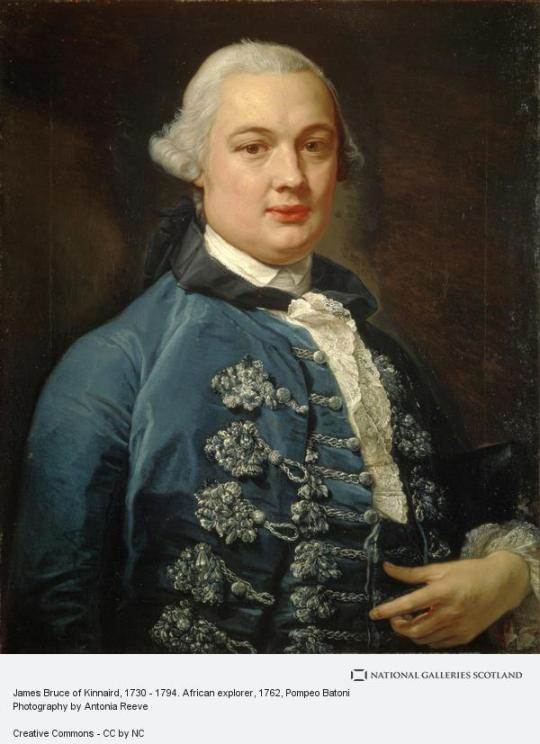

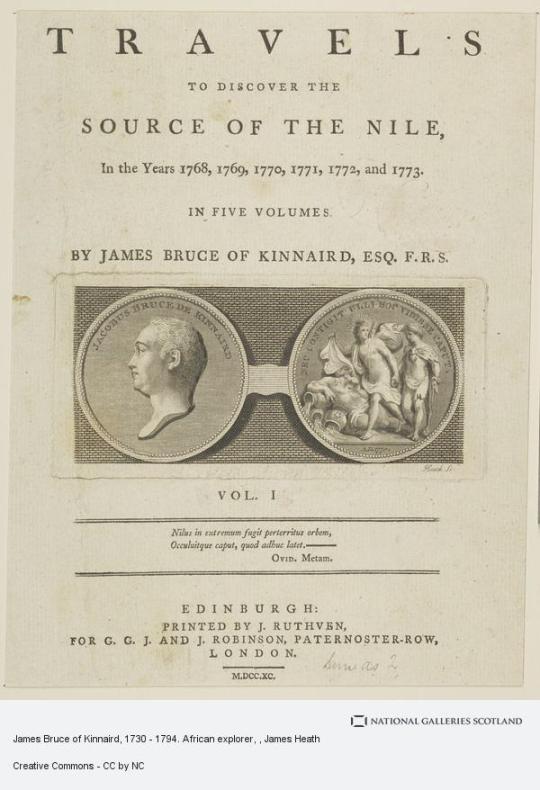
April 27th 1794 saw the death of James Bruce, the explorer at Larbert.
At six feet four inches in height, James Bruce was an impressive figure. An explorer, archaeologist and brilliant linguist, he travelled across North Africa, Crete, Syria, Egypt and Ethiopia He is best known for his exploration of the sources of the Nile, reaching the headstream of the Blue Nile in 1770.
Some historians believe that Bruce, while being recognised for finding the source of the Nile, he was actually in Africa on a secret personal mission to Ethiopia to locate a sacred religious relic, the Ark of the Covenant.
The explorer apparently charmed and gifted his way through a land usually hostile to foreigners. On his black horse Mizra, Persian for ‘scholar’, he trekked across treacherous terrain and Ethiopia’s flat-topped mountains. He brought a telescope so large it required six men to carry it.
Bruce arrived at Ethiopia’s imperial capital Gondar during a smallpox epidemic. His knowledge of medicine gained him entry to the court – where he would remain for almost a year.
James Bruce had relationships with many women in Ethiopia, including the Princess Esther. He later described this period as “one of the happiest moments of my life”.
At court, Bruce boasted of his own lineage, declaring:
“My ancestors were the kings of the country in which I was born, and to be ranked among the greatest and most glorious that ever bore the title of king.”
This was not just him boasting, his family were indeed descendants to King Robert.
On returning to London Bruce’s tales of Ethiopia, recounted at dinner parties and gossiped about in letters, were met with disbelief. He became a figure of ridicule, mocked by contemporaries such as Samuel Johnson and James Boswell. Ultimately, he would be laughed out of London.
There were, perhaps, ulterior motives for Bruce’s rejection by ‘polite’ society. In her book Plotting To Stop the British Slave Trade: James Bruce and His Secret Mission to Africa, Jane Aptekar Reeve reveals that Bruce belonged to a secret network of British slave trade abolitionists.
The Scottish cartoonist Issac Cruikshank made James Bruce a caricature, depicting his story of the “Abyssinian Breakfast”, in disbelief of Bruce’s claims that Ethiopians took live cuts of meat from cattle. This was later proven to be true, as indeed were his other stories that saw him ridiculed.
For a man who must have been in grave dangers during his adventures in Africa, he had an inglorious death, he fell down some stairs in 1793 and died at his home in Kinnaird, and is buried in a graveyard I visit now and them at Larbert Old churchyard near Falkirk.
Pics are of the cartoon I mentioned, and his rather unusual memorial at Larbert, which I read last year id due to be restored soon, hopefully.
Much more on the man here https://www.historic-uk.com/.../HistoryofSco.../James-Bruce/
14 notes
·
View notes
Text
Some random RusAme vibes
youtube
@ironic-orange you must check it!
I CAN’T HELP MYSELF
The sky is shining, light through the smallpox of stars Like an outburst of anger, I'm a guest in my own house I can't help myself I can't help myself
I fell to the floor like a broken vase Like in the old fairy tale, I didn't know who was the wolf I can't help myself I can't help myself I kiss the body Bruises and veins Freckled shoulders and The contour of bitten lips I kiss the body Bruises and veins Freckled shoulders and Bitten lips
I remembered a dream where we were together We tortured the day, we tormented the night We bled our dream And this blood didn't dry on the knife I remember the dream where we were together We tortured the day, we tormented the night We bled our dream And this blood didn't dry on the knife
Your style of clothing is like a meeting of widows And your smile looks like grinding of teeth I can't help myself I can't help myself Now I don't like the shine of amber eyes It's easy to be with me, but not this time I can't help myself I can't help myself I remembered a dream where we were together We tortured the day, we tormented the night We bled our dream And this blood didn't dry on the knife I remember the dream where we were together We tortured the day, we tormented the night We bled our dream And this blood didn't dry on the knife
The sky is shining, light through the smallpox of stars Like an outburst of anger, I'm a guest in my own house I can't help myself I can't help myself
29 notes
·
View notes
Photo

The Brown Lady of Raynham Hall
In 1936 Captain Hubert C. Provand was taking photos of the picturesque Raynham Hall, a country house in Norfolk, England, when he snapped this picture.
As Provand was setting up the shot, his assistant called out for the photo to be taken ‘now’, as something was descending the staircase. The result is this world famous ghost photo, said to be that of Lady Dorothy Walpole.
September 19, 1936: Photographer, Captain Hubert C Provand and his assistant, Indre Shira were taking pictures of Raynham Hall, Norfolk, England for the December issue of ‘Country Life’ Magazine.
Little did they know that on this day they would capture the ghost that has said to be haunting the old country house since the mid 1800’s.
The ghost is better known as the ‘Brown Lady’, as the spectre has been described as wearing a brown silk brocade dress.
It is believed that the Brown Lady is the spirit of Lady Dorothy Walpole, who died at Raynham Hall in 1726 from Smallpox, after a long incarceration within the houses walls.

Dorothy Walpole was the sister of Sir Robert Walpole, who was considered to be the first Prime Minister of Great Britain (serving 1721 to 1742 which would also make him the longest serving Prime Minister). Dorothy was Charles Townsend’s second wife, Charles having served as the secretary of state for ten years.
It is said that Dorothy had an affair with the 1st Duke of Wharton, Philip Wharton (yes all these upper class families make for quite complex reading and research), and her husband, Sir Walpole did not take too kindly to that, and had Dorothy locked in the upper floor rooms of their home – Raynham Hall.
Another story states that Dorothy was entrapped by the Countess of Wharton, never to leave the house… not even to see her children. It is said she returns to find, and finally be reunited with her children. A sad tale indeed!
Either way Lady Dorothy Walpole died of Smallpox 29th March 1726 aged forty.
The Brown Lady aka (possibly) Lady Dorothy Walpole has been seen on a number of occasions since her death, with the first recorded sighting being in 1835 after a Christmas party. Several guests had seen the ghost as they went up to their bedrooms for the evening, one describing it as having a glowing face but with empty eye sockets.
Captain Marryat (a gentleman who wrote novels set out at sea) retired to his room one night, and had remarked to two others he met on the way that he was carrying a gun as protection against the Brown Lady. It was at this point the apparition appeared and ‘diabolically’ grinned at the captain as she passed by him.
The captain took two shots, both passing straight through the apparition, to embed in the door and door frame beyond.

Many other people have witnessed the Brown Lady on the main staircase and in the bedrooms. Generally these sightings occur when heading to bed, or waking up in the middle of the night to find her standing in their rooms.
The ghost has also been seen right before tragic events and deaths that affect the Townsend Family. One evening, during a dinner party, many guests had seen the apparition, complete with her brown dress, walking through the crowd. The Spectre did not seem to recognize anyone and soon disappeared. The next morning, news of the death of George Walpole reached the group at the estate, George had died at about the same time the Brown Lady has been seen.
On the fateful day the photo was taken, Captain Hubert C Provand and his assistant Indre Shira had set up the camera at the foot of the main staircase, with Provand under the protective cloth at the back of the camera. They had already taken one photo and Provand was re framing for another shot. Shira suddenly called out to Provand to take another shot and at this Provand removed the lens cover and made the exposure.
Shira had seen the figure of a lady descend the staircase when he called for the photo to be taken. Upon development, the image did indeed show a spectral figure on the staircase; The Brown Lady had been captured at last!
The picture was published in Country Life magazine December 16th 1936, along with the accounts of Provand and Shira.
Renowned paranormal investigator Harry Price interviewed the two men and stated he could not find a flaw in their story, as the negative also showed the figure. With the exception of the two men lying, he could not see how the image could be anything but that of the ghost in question.
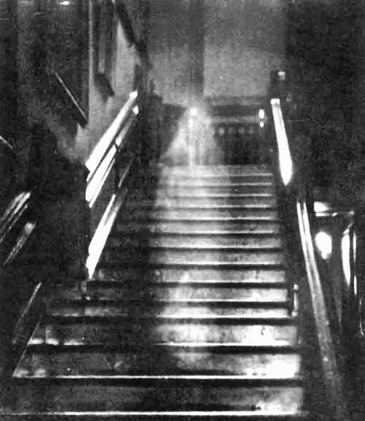
#The Brown Lady of Raynham Hall#the brown lady#Raynham Hall#Haunted Location#paranormal#ghost photo#ghost#hauntings#spirits#ghost and hauntings#ghost and spirits#haunted salem#myhauntedsalem
27 notes
·
View notes